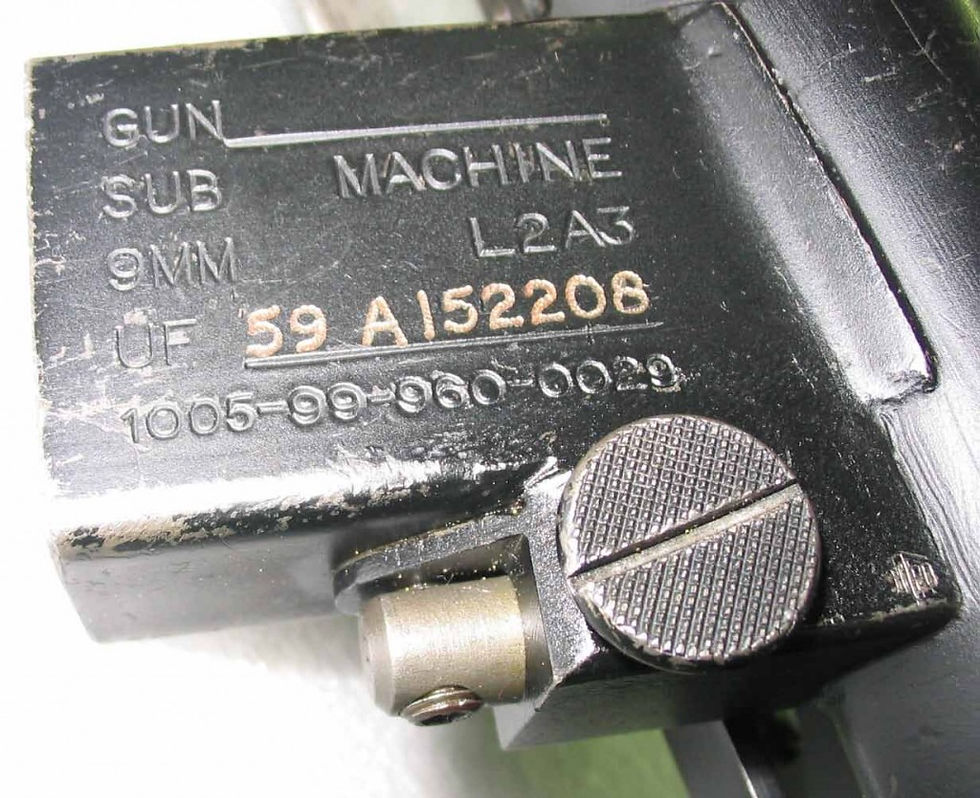
A more detailed read on the history of the serial numbers.









serial numbers, history of patchet and sterling variations
"George W. Patchett, the lead designer at the Sterling Armaments Company, began redesigning the Lanchester in 1942. The wooden stock was binned and replaced by a folding stock and a pistol grip, which was located near the weapon's point of balance. Dubbed the Patchett submachine gun, it was more modern than the Lanchester, yet more refined than the Sten.
While very different, the Patchett did share two similarities with the Lanchester. It retained the side-mounted magazine and full-length barrel jacket. Over the next couple of years, it was further improved and refined. In April 1944 it was considered good enough by the British Army for a limited run of approximately 100 pieces to be made. While these were intended for trials, some were issued to the 6th Airborne Division and saw combat at Arnhem. Despite positive reports, the new design was not adopted.
When the war ended, the British initially lost interest in adopting a new design. Arms rooms were filled with perfectly serviceable Sten guns. Another competitive trial was held in 1947 among four designs with a Sten tossed in as a control weapons. Three British designs, from Enfield, BSA and Sterling, and one from Australia were tested.
Although the tests were inconclusive, Sterling continued working on and pushing its design. The next obstacle Sterling faced, was the futuristic EM-2 rifle. This was intended to replace both the .303 Lee-Enfield rifle and the Sten submachine gun. However, U.S. pressure meant the EM-2 never materialized.
Further trials eventually led to Sterling Armament Company's Patchett design being approved for service on 18 September 1953. It was dubbed simply Submachine gun L2A1. Over the next few years, small changes were made, leading to the L2A2 in 1955 and L2A3 in 1956. The L2A3 would become the standard model and soldiered on with British forces for decades.
What of the design itself? The basic piece is fairly compact and nicely laid out. Unlike the earlier Lanchester and Sten Mk V, it's constructed entirely of steel and plastic. The design is fairly straightforward, with its roots in the original MP18.
As you would expect, it fires from the open bolt position and utilizes the advanced primer ignition system. This means the cartridge is still moving forward at the instant of firing. In addition, the system is designed so the firing pin only aligns with the primer after the cartridge has entered the chamber.
The relatively heavy bolt also has distinctive helical grooves cut into it. These are to aid reliability in very dirty conditions. Rather than a single spring, two, an inner and outer, return springs are fitted. The barrel is 7.8 inches long with a 1:9.8 right-hand twist.
When it's not required, the stock can be folded out of the way beneath it. Overall length is 27 inches with the stock extended and just 19 inches with it folded. Not only is the Sterling compact, but it's also fairly light at just 6 pounds without magazine.
Sights consist of a front blade adjustable for windage and elevation and a dual aperture rear. The rear sight features settings for 100 and 200 meters.
Like the MP18, MP28 and Lanchester that came before it, and its rival the Sten gun, the Sterling feeds from a side-mounted magazine. While it can utilize a 32-round Sten magazine, it has its own proprietary magazine, a 34-round double-column box that proved significantly more reliable than the problematic Sten magazines.
The Sterling design is curved, staggered feed and equipped with rollers to reduce friction. Thanks to the well-designed and robustly made magazines, the Sterling was not afflicted with the magazine related issues that haunted the Sten.
A selector lever is conveniently located on the left side of the pistol grip. Pushing it all the way forward provides full-automatic fire at approximately 550 rpm. The middle position provides semi-automatic operation and fully to the rear is Safe"
QUOTED FROM:
http://www.thefreelibrary.com/Century%27s+Sterling+II+a+fun+semi-auto+variant+of+the+famous+British...-a0236643362
serial numbers
The book "The Guns Of Dagenham" only goes through serial number S11067 (last serial number made in 1974), so a guess of manf date would be 1975 or 1976.
On the bottom of the mag well will normally be the Sterling patent numbers. An "S" on any parts indicates Sterling manf as opposed to UK Government arsenals.
(Guns Of Daganham), lists a total of 13,311 Sterling Mk4s being purchased by Iraq along with 35 Mk5s.
The serial number you list is still a mystery although I did find reference to about 10K Mk4s built from 1972 to 1974 using the S prefix and these were NOT the silenced Mk5.
No record of a S serial number prefix going as high as the one you listed in the GOD, but there are several errors in that publication.
Commercial Mk4s produced after a further change of ownership of the Sterling Armament Corp. were prefixed with the letter S in honor of owner James Edmiston's wife, Sisi. So after mid-1972, commercial Sterling Mk4s were marked S XXXXX.
This should give you a year of manufacture of your parts kit built L2A3 Sterling.
1972... S prefix marked from 1001 to 4411
1973... S prefix marked from 4412 to 8672
1974... S prefix marked from 8673 to 11067
http://www.uzitalk.com/forums/showthread.php?68349-Sterling-L2A3-Serial-Number-question&p=594383&viewfull=1#post594383
example serial numbers
KR96089 and KR93943
KR96089 was made in December of 1965.
KR93943 was either late October or early November of 1965.
KR33952 was made in October 1959
